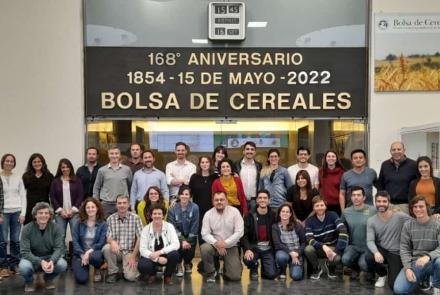Harvest Expands Work in Argentina with New Multilateral Training Program
Satellite imagery has revolutionized modern agriculture. Much like the Green Revolution in the latter half of the twentieth century greatly improved agricultural productivity and yields; today’s Digital Agriculture Revolution is allowing farmers to more easily and effectively monitor their crop condition throughout the growing season and improve management strategies to further boost yields.
NASA Harvest, in partnership with the University of Maryland (UMD), the Buenos Aires Grain Exchange (Bolsa de Cereales), the Argentinian Ministry of Education, and the International Development Bank, has launched a training program within Argentina to teach agricultural professionals how to access and analyze the multitude of open access satellite imagery that’s become available over the past several years.
Professors from UMD will teach participants the fundamentals of remote sensing; discuss the variety of satellite imagery, or Earth Observation (EO) data, available; and demonstrate the various kinds of analysis researchers are using to better monitor global crop production. Lessons will be taught by faculty from the UMD Geography department's MSGIS program, including Jianguo Ma, Jonathan Resop, and Rejanne Le Bivic as well as NASA Harvest’s AI Lead, Hannah Kerner; Crop Condition Co-Lead, Ritvik Sahajpal; and Data Portal Lead, Michael Humber. Estefania Puricelli, Markets and Trade Co-Lead for NASA Harvest, is coordinating the program.
This program continues the work the NASA Harvest program is doing in Argentina. In 2021, Harvest and Bolsa de Cereales started an educational program aimed at high school students in rural schools around the capital of Argentina, Buenos Aires. UMD professors and partners at Bolsa constructed a curriculum that taught students how to access and analyze EO data using the same techniques that NASA Harvest uses. Students finished the semester by designing and conducting a field data collection campaign, gathering measurements on crops in their local communities that help inform agricultural models. After a successful inaugural year, the program is currently in its second year with more than 400 students from 40+ schools in the region.
In addition to educational outreach, Harvest is collaborating with SIMA, private sector digital agtech platform provider who operates throughout Latin America, to use EO data to accurately predict crop yields at the field scale. This partnership resulted in a smartphone application that allows users to better monitor fields and pinpoint management decisions.
Puricelli, program coordinator, is excited to continue Harvest’s work in Argentina and is hopeful that this program can be expanded to other Latin American countries. “This program allows us to improve already existing national capacity - training commodity traders, extension agents, farmers, and business leaders in the use and analysis of remote sensing data. Importantly, we are developing a transferable framework that we can deploy in other countries. Increasing capacity throughout the region is vital in ensuring that farmers, policymakers, and other stakeholders are able to fully realize their potential in this new digital agricultural age.”

